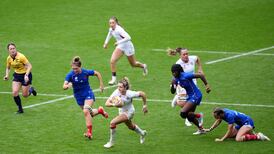AnalysisWALES ARE a bloody good rugby team, but a team with weaknesses. They have a wonderful style but with weaknesses.
They have a defence with weaknesses, a lineout with weaknesses and a scrum with weaknesses but in the end Ireland were just too weak to exploit any of them. Everything Gatland has done in Wales has been by choice. He chose to accept the job, he chose both Shaun Edwards and Rob Howley. He chose the Welsh style of play. And finally he chose to create competition for places. All his choices have been spot on and he has flooded a talented group with confidence who have achieved a trophy by playing rugby.
Conversely Ireland chose to wait until six minutes and 17 seconds for Eoin Reddan to pass to Ronan O'Gara. In doing so they set out quite clearly that Shane Horgan, Brian O'Driscoll and Robert Kearney were here to observe. This is criminal. On Saturday I highlighted the biggest weakness in the Welsh defensive system: Gavin Henson. Apart from two mighty hits, one on Horgan, he looks like he is in cloud-cuckoo land. Everything he does is slow and ponderous but Ireland chose not to target him. He is a fine athlete and I would never run straight at him but his concentration levels are minute. He was not tested and that is unforgivable.
This is all the more galling when you look at the Irish team sheet. There is far too much talent available to resort to 10-man rugby. Horgan had a big opening creating real problems. O'Gara was brilliant. But in Robert Kearney Ireland have an All Black in the making. He can catch, he can defend and boy can he kick. But most importantly he can run. And finally he can counterattack.
In many ways Ireland's limitations in game plan were best illustrated by an appalling counterattack in the 27th minute. The Welsh kicked long to Denis Leamy, who rightly countered hard looking for Irish support. Of the remaining 14 players Trimble was the only one to offer. He took the pass from Leamy and then passed it straight back where the "attack" died.
With my great view from Section 509 this Irish team had no counterattack plan. What would Munster, Leinster or Ulster have done with such an opportunity to run back a poor Welsh kick?
Matthew Rees's late change at hooker provided the Irish with a perfect opportunity to target the Welsh lineout, where both O'Connell and O'Callaghan spoiled them at critical times. And from the off, Ireland had a very specific game plan, one that prioritised ball retention. As a result for the first time this season these hard-yard tactics had the Croke Park crowd roaring. Both the Welsh and Irish support sensed a magic day unfolding. The Irish team battered away around the fringes with big carries from Leamy, O'Connell and the hard- working Hayes, who even crawled through one ruck. By the half hour with the score 6-3 in Ireland's favour I began to notice a Welsh side figuring things out.
Their lineout began to provide quick off-the-top ball and their shape and pattern began to unfold. Regardless of how they secured possession all 15 Welsh men played to the same pattern. Conversely Ireland ran out of shape and ideas when they went beyond the fringe attack. But most worryingly, Shane Williams began to pop up in random spots, sniffing out opportunities. So as half-time approached the signs were ominous. To add to my fears Ireland once again lacked a true understanding of the sinbin.
Against Scotland last year and Italy this year Ireland failed to up the tempo and hammer home the advantage. On Saturday Ireland played against 14 men for 20 minutes and managed a net three points. For 10 minutes Shane Williams played at scrumhalf. Did Ireland attack his vacant wing? Did Ireland attack his lack of knowledge as a scrumhalf? In fact Wales beat Ireland 3-0 during these 10 minutes. Remember this was a home fixture for Ireland.
On Saturday I pointed out several areas for Ireland to focus on, the major one being the 5ft 7in Shane Williams. The longer the game unfolded the more his influence grew. I have harped on about defence over the weeks and once again Ireland's defensive system malfunctioned, much as it did for Scotland's only try against Ireland.
When Stephen Jones picked up the ball in Ireland's half he had two Welshmen outside him and faced six Irish defenders. No problem. When Williams got the ball he faced three defenders. No problem. But the defenders failed to move forward and allowed the brilliant Williams space and time. The Welsh converted a three-versus-six into seven points. He should never have scored. But the system malfunctioned.
This match promised so much and eventually dwindled towards the final whistle with Wales the deserved winners and as I exited Croke Park I asked myself how can such Irish talent play a game foreign to their natural ability?
• Old Christians are arriving from Montevideo, Chile, this week. In May 2006 Lansdowne FC toured Argentina and Chile. On Saturday, May 20th, we all sat in our hotel witnessing Munster's amazing win over Biarritz. We then played Old Christians followed by a substantial barbecue. Then Roberto Canessa strolled to the front and recounted his personal experience of Alive. Munster winning the Holy Grail followed by Canessa, a day I'll never forget. Our picture is in my wallet to this day. He's in Croke Park on Wednesday. Go. His words will change you.
From the off, Ireland had a very specific game plan, one that prioritised ball retention











